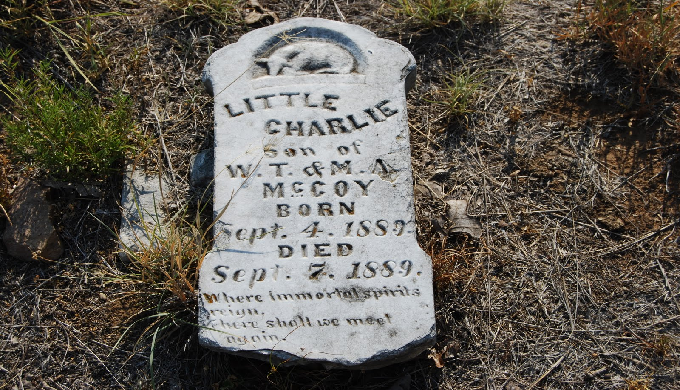 letsbewild.com
letsbewild.com
History
7 Oddly Named Ghost Towns of the Texas Hill Country
Ghost towns are scattered throughout the Texas Hill Country. Some failed to thrive because of flooding, some because of that evil Boll Weevil resulting in failed businesses, and some because they were just too far from civilization. However, how did some of these ghost towns end up with such strange names? Here are few of the most oddly named ghost towns of the the Texas Hill Country.
1. Baby Head
 Photo: the thousand day journey
Photo: the thousand day journey
About ten miles north of Llano, is a ghost town called Baby Head. The town got its name after an infant’s skull was found on Baby Head Mountain. It is said the skull was left by a hostile group of Native Americans. The town built a post office in 1879 and was home to several small businesses, and a school. The town held a county election at one point. By 1968, Baby Head was home to only 20 residents. Today, all that remains is a cemetery and a historical marker. Baby Head is no longer on the state map.
2. Fly Gap
About twelve miles northeast of Mason and 1/2 a mile west of Ranch Road 1900 lies a ghost town called Fly Gap. Legend has it that a group of settlers were staging an ambush in a gap of the Kothmann Mountains. They tied their horses to a nearby thicket, and when the settlers returned to the horses, they found the horses were all badly bitten by flies. Dozens of families settled about two miles away by 1883, and in 1884 a school, a church, and a post office were built. The post office was closed by 1898 and the original school burned down in 1917. A new schoolhouse was built in its place shortly thereafter. The schoolhouse had eventually been converted to a community center and was home to the Fly Gap Community Club in the 1970s. By 1980, all that remains of Fly Gap is the schoolhouse and the cemetery, which can still be seen today on Fly Gap Road.
3. Nameless
 Photo: onlyinyourstate.com
Photo: onlyinyourstate.com
Of all the ghost towns in Texas, how Nameless got its name is probably the most amusing. About 30 minutes northwest of Austin, just off farm road 1431 on Nameless Road, is the ghost town of Nameless. In 1869, the town formed, and submitted a name, six times, to the post office department in Washington. Each time the name was rejected. In frustration, the residents of the town wrote back to the postal authorities, “Let the post office be nameless and be damned!” And so it was. In 1880, the department granted the towns “request” and was called Nameless. By 1884, the town was home to around 50 residents, a church, a school, and a general store. by 1890, the post office closed and all mail was then sent to Leander. In the 1940s, Nameless was home to two churches, a business, and a few homes. Nowadays, town information is no longer available, and Nameless Road and Nameless Cemetery are the only signs that a town ever existed there.
4. Teacup
Named after Teacup Mountain, which looks distinctly like an inverted tea cup, this ghost town was home to only 10 residents and a general store. The general store may have also functioned as a post office. This town seemingly vanished into thin air. No census has been performed since 1947.
5. Exile
Exile was jokingly named because of its isolation from civilization. It is located near the junction of the Dry Frio River and Mare Creek. In 1890, a post office operated on the ranch of W.C. Lee, who was also the post master. By 1896, the town’s school/church educated 56 children and was taught by one teacher. The church was named The Exile Missionary Baptist Church and was later renamed The Dry Frio Baptist Church. The church later moved to the Heard (also now a ghost town) community school and the town of Exile was abandoned by 1946.
6. Nix
 Photo: The Nix Store Facebook Page
Photo: The Nix Store Facebook Page
Nix is a ghost town originally settled in the early 1880s along a stage coach and mail route that ran out of Lampasas. It is located 11.5 miles west of Lampasas on Ranch Road 580. Two mills and a cotton gin operated within this small town and the population quickly grew from 8 to 27 residents. In the 1920s and 1930s, Lampasas County drilled for oil and found it. However, Nix quickly became known as the only city in the county to have a test well come up dry. In the 1940s, Nix was still home to a church/school combination and a store. By the year 2000, the population had dropped to six. The store has been preserved and is still standing. In 2011, it was re-opened as an antique store, but today no longer appears to be a functioning business.
7. Fly
There’s not much to be said about Fly, TX in comparison to other ghost towns. There is no reference as to how it got its name. However, in 1907 it was home to school where two teachers taught 116 children. By the 1920s, the residents of Fly moved to Hondo, TX and leased their lands to farmers. The school still functioned up to 1947, but was abandoned by 1980. The school is said to be haunted, but is located on what is now private property.
References:
Texas State Historical Association


